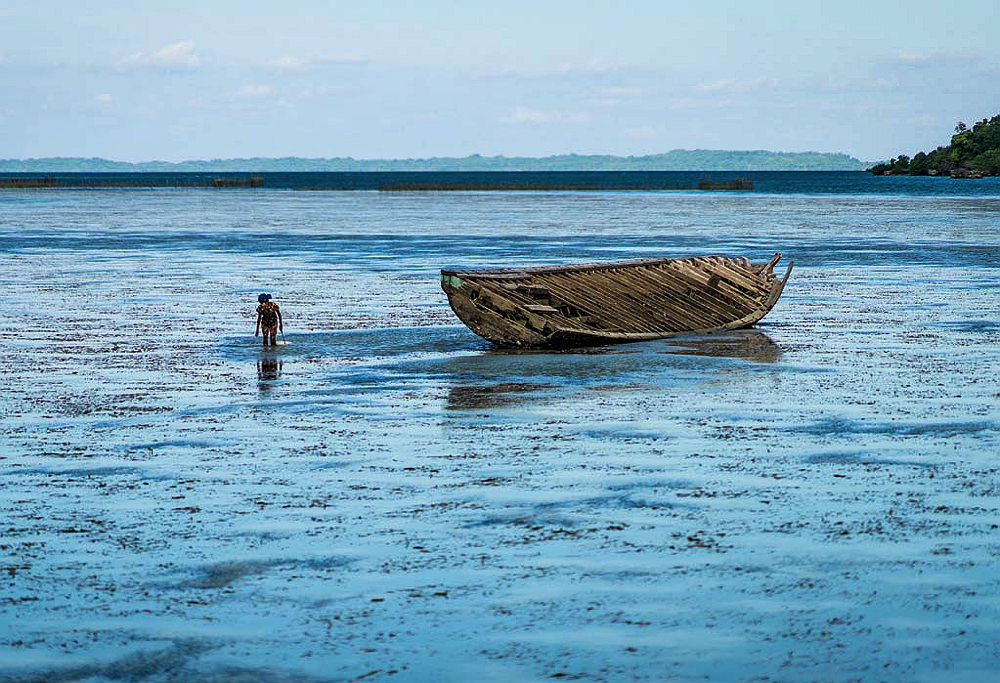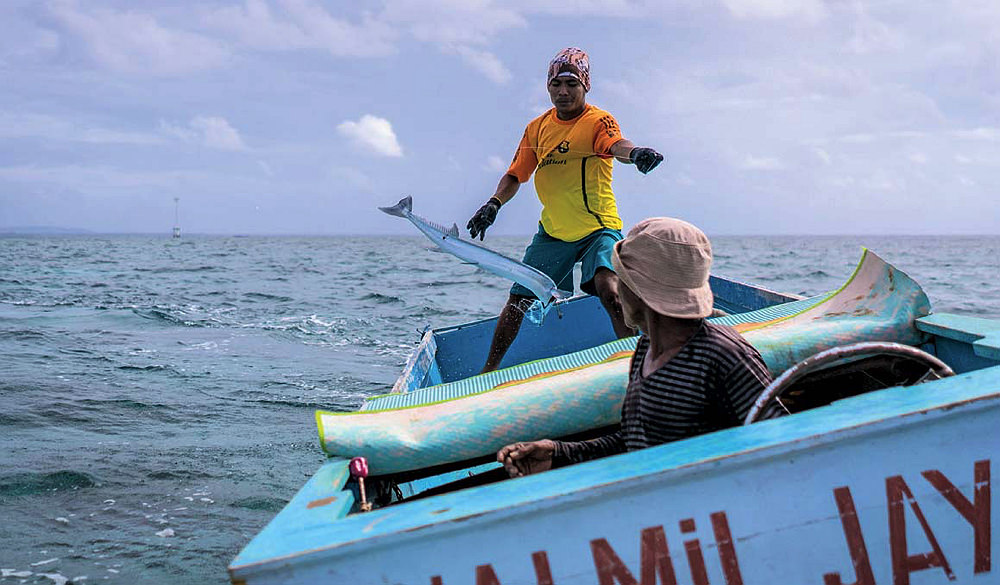“I fully expected to find a place where survival depends on the whims of the ocean, where the line between hungry and full rests on what you can hunt and gather,” wrote photographer David Hu ’16 in a progress report during his stay with the Bajau of Sampela, a seafaring community off the coast of Kaledupa Island in southeastern Indonesia.
“The reality is that this line is growing even thinner.”
In the spring and summer of 2017, Hu lived with Bajau who are one of the last remaining communities of an ocean-faring people—sea nomads, or sea gypsies, they are still sometimes called—whose way of life stretches back hundreds of years. And in this century, it is increasingly threatened. At one time, the Bajau were fully nomadic, roaming parts of Indonesia, Malaysia, and the Philippines and living in dugout houseboats, called lepa lepa, made from teak. A few still do, but most Bajau, including those in Sampela, a village of about 1,000 people, now live in huts built on stilts that stand a few hundred yards from land, connected to each other by a series of piers and walkways. Depending on the tides and the time of year, the water beneath the village’s homes can be anywhere from several inches to about eight feet deep.
Hu is a photographer and a scientist whose work in both fields has taken him to remote corners of the world. At Harvard, he concentrated in organismic and evolutionary biology and volunteered as an EMT; his long-term plans include medical school and a career as a physician. (He currently researches craniofacial development in associate professor Eric Liao’s plastic surgery laboratory at Massachusetts General Hospital.) But, Hu says, “I have always loved photography.” He first picked up a camera as a teenager and got serious about it a couple of years ago. He has traveled to Rwanda to research the country’s trauma and prehospital care, and to photograph its mountain gorillas: arresting, sensitive portraits of endangered animals. In the Congo he and his camera shadowed local porters hired to carry trekkers’ gear up to the summit of Mount Nyiragongo, an active volcano. Last February, he accompanied research fellows from Massachusetts General Hospital’s wilderness medicine division to Nepal, where he helped gather data on altitude illness and photographed people in the Himalayas (see “Medicine in the Middle of Nowhere,” November-December 2017, page 43). Closer to home, Hu has chronicled the ice-climbing exploits of the Harvard Mountaineering Club, of which he was also a member.
His trip to Indonesia—a country he visited first as a tourist, intrigued enough to return—was funded by a George Peabody Gardner Traveling Fellowship from Harvard, which provides postgraduate support for immersion in a foreign culture. While he was there, he lived and ate and worked with a host family in one of Sampela’s stilted homes. His purpose was to learn the Bajaus’ techniques for fishing, cooking, sailing, making boats, and gathering food. And to begin to answer a question whose seeming simplicity belied its depth: “What does it mean to be Bajau?”

A Bajau elder navigates the shallows surrounding the village to gather urchins and conchs to eat or sell.
Photograph by David Hu

A Bajau elder navigates the shallows surrounding the village to gather urchins and conchs to eat or sell.
Photograph by David Hu

Most residents still use manual or sailing canoes, like the woman cleaning and charring the hull of her hand-built canoe.
Photograph by David Hu

Several men fix a broken electrical cable by matchlight during a monsoon storm—an improvised repair to a previous improvised repair. As these men worked, the lights of the nearest house, and of the other houses connected to it, flickered on and off every time the two bare wires—each containing 240 volts—touched.
Photograph by David Hu

Satellite TV dishes have begun appearing outside Sampela homes, a marker of some residents' wealth and the increasing presence of technology.
Photograph by David Hu

A young woman harvests food—octopuses, urchins, conchs, sea cucumbers—at low tide near Sampela.
Photograph by David Hu

Although spearfishing is most traditional, some Bajau fishermen also use other methods. With a lure made from a plastic bag, two men go longlining for houndfish.
Photograph by David Hu

Some Bajau communities are still fully nomadic and live year-round in lepa lepa houseboats. Sampela residents use these boats for long journeys to distant fishing grounds and to travel to other Bajau communities in Malaysia and Indonesia.
Photograph by David Hu

Using a homemade speargun and wooden goggles, an older man hunts for triggerfish in the reef. During days-long fishing trips, recalls photographer David Hu, all meals are fish. "You'd shoot a fish, get back on the boat, clean it—though you don't even really gut it—you just cut pieces off and eat it raw. Then go back for more fish."
Photograph by David Hu

Reef damage from dynamite fishing often means that Bajau fishermen must dive deeper and longer to find fish.
Photograph by David Hu
The Bajau get most of their food from the ocean: all the men in the village are fishermen. Every day they take boats out to the fishing grounds—the locations are often tightly guarded secrets—where they dive down with goggles and spearguns (both traditionally made of wood, though now sometimes modern gear). Holding their breath for minutes at a time, they hunt triggerfish, parrotfish, and other reef fish—some to eat and some to sell. Boys begin diving as young as five or six, and they will fish for as long as they are physically capable. Meanwhile, closer to the village, women, girls, and the elderly gather octopuses, sea urchins, and sea cucumbers. (Other necessities, such as rice and fresh water, are brought in by boat from the mainland.)
But there are new pressures. Climate change brings stronger and more frequent storms—Hu recalls whole days spent sitting inside his hosts’ home, listening to the wind and rain, waiting for the weather to pass so they could fish again. “In the weeks that I have been here,” he wrote in his late May progress report, “the number of days with storms strong enough to shake my stilted cabin have far outnumbered days of calm and sun.” The number of fish available has also declined sharply in recent years. Overfishing is part of the problem, but dynamite and cyanide fishing in the Sampela area—practices now banned, though the bans are not always enforced—have also taken a toll. “In some places, you would dive down into the water and find these massive craters in the coral from years back,” says Hu, who first learned freediving as a teenager in Florida and went fishing most days with the Bajau men. The scarcity of fish, he says, drives spear fishermen deeper and deeper in search of large enough fish to catch, risking stronger ocean currents and blackouts from a lack of oxygen.
Meanwhile, technology has added convenience and complexity to life in Sampela, fusing tradition and modernity. Electricity arrived three years ago; the power is usually on from about 5:30 to 10 each evening. Houses are connected by thin, often exposed wires, and when one house loses power, so do all the others after it on the circuit. Newly installed PVC pipes have begun to bring fresh water to the village, although the water pressure can be unstable. But most homes still use bucket showers, and toilets are simply holes cut in the floor through which waste drops into the ocean. Many people have cell phones, though the service is spotty, and some—including Hu’s hosts—have satellite television. What do they watch? With a smile, Hu says, “WWE is very popular.”








